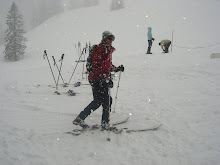The drive from the Pudre Canyon in Colorado to Salt Lake City was really a long one, perhaps too large of an undertaking in fact. I first drove north to Laramie, Wyoming to pick up I80. Laramie is the home of Wyoming State University and also is the highest college campus in the continental USA at 7,200 feet, nice and high (-; Coming into Laramie the snow was blowing unbelievably hard and the flakes were as big as cotton balls, making driving slow and tedious.
Nearly the entire way to Salt Lake City on I80 from Laramie was snowy. What should have taken a 7 hour trip, took nearly 9 hours and arrived in Salt Lake at about 3:30am. The next day I slept in and rested at the Marriott Courtyard, a lovely accommodation. I awoke at 5:15am the next morning to 3-4 inches of snow in Salt Lake. Until driving perhaps 1-2 hours outside of Salt Lake the driving was slow and treacherous. I was sharing the road with really only big trucks and to pass them in the snowy/icy left lane was rather unnerving. Once again during my trip, I wish I was wearing a set of good snow tires.
Passing through western Utah was suuper windy, with periods of blowing snow that only allowed sight distance of about 100 feet or less. With the sunrise came a break in the weather and dry, but cold conditions. Crossing into Nevada, I stopped a cool truck stop cafe in Wells for breakfast. The range outside of the truck stop looked like this:
 All the slot machines were a surprise at the entrance to the cafe, but the delicious breakfast and wonderful service allowed me to keep moving. As I passed through Nevada, I attempted to take some photos of the countryside as I drove and I think they came out pretty well:
All the slot machines were a surprise at the entrance to the cafe, but the delicious breakfast and wonderful service allowed me to keep moving. As I passed through Nevada, I attempted to take some photos of the countryside as I drove and I think they came out pretty well:
The above photo is entering Nevada (pretty much). It is quite interesting to identify the snow line, below I reckon it is about 6,000 feet.
 A cool massif.
A cool massif.Unfortunately as I went through Reno and into California it got really crowded on the highways and so I could not take anymore road shots. Lake Tahoe was beautiful and full of snow, but surprisingly low on elevation. It must be their proximity to the ocean and perhaps lake-effect that gives Tahoe its special snow. Descending into the Bay Area near Sacramento was amazing. The ecosystem changed so rapidly that one moment I am in a coniferous, snowy forest and next I see heaps of palm trees! Only in California...











